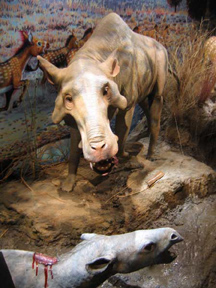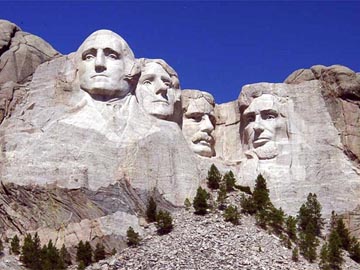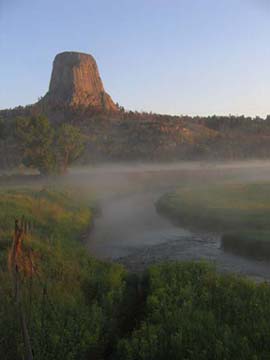|
Travels in Geology July 2006, posted July 14, 2006
Summer roadtrip: Driving to "West Dakota"
Callan Bentley, Geotimes contributing writer, has been traveling across North America in his Volkswagen Westfalia camper van this summer. Since May, he has been logging miles from Washington, D.C., up to central Alaska, and will soon be heading back. When he comes across areas with interesting geology, he uses the van's solar power to plug into a laptop and fire off a dispatch for Geotimes. The following is Part I of his three-part roadtrip series.
 For those
with an interest in all things geologic, the western portion of South
Dakota and the adjacent area of eastern Wyoming are wonderful spots to
visit. From Badlands National Park through the Black Hills to Devils Tower,
four hours of driving generates a roadtrip through a region that has much
to entertain geo-philic travelers.
For those
with an interest in all things geologic, the western portion of South
Dakota and the adjacent area of eastern Wyoming are wonderful spots to
visit. From Badlands National Park through the Black Hills to Devils Tower,
four hours of driving generates a roadtrip through a region that has much
to entertain geo-philic travelers.
Erosion by infrequent rainfall dissects
the sediments and volcanic ash of Badlands National Park in South Dakota,
into weird and exotic shapes. All photos are by Callan Bentley.
Let's imagine that you're driving from east to west (as I did). Perhaps
one of the first items you'll notice are roadside billboards advertising
Wall Drug that besiege you along your drive on Interstate 90. Although
Wall Drug isn't known for being of geological interest, it is the original
tourist trap that unabashedly advertises itself as a tourist trap. Located
in Wall, S.D., this labyrinthine collection of stores, kitsch and eateries
adds some new
attraction every year. This past year, an animatronic Tyrannosaurus
rex was added to the lineup to commemorate the former reptilian
residents of the area. If you have a sense of irony, it's worth stopping
just to watch this lethargic model "roar."
Also in the town of Wall, and positively neglected by comparison, is the visitor center for the National Grasslands, 4 million acres of publicly owned prairie administered by the U.S. Department of Agriculture. Specific information is available on nearby Buffalo Gap National Grassland, as well as the entire system of public lands.
 South
of the road near Wall is Badlands National Park,
an excellent example of badlands topography, a characteristic landscape
that results when loosely cemented sediments in arid locations are dissected
by periodic rainfall. The sediments range in age from Cretaceous to Miocene.
The oldest deposits are associated with the Western Interior Seaway, a
body of seawater that stretched from the Gulf of Mexico to the Arctic
Ocean from about 140 million to 60 million years ago. Fossils of baculites
— ammonoids with straight, not spiral, shells — mingle with
vertebrates like pteradons, mosasaurs and the giant turtle Archelon.
South
of the road near Wall is Badlands National Park,
an excellent example of badlands topography, a characteristic landscape
that results when loosely cemented sediments in arid locations are dissected
by periodic rainfall. The sediments range in age from Cretaceous to Miocene.
The oldest deposits are associated with the Western Interior Seaway, a
body of seawater that stretched from the Gulf of Mexico to the Arctic
Ocean from about 140 million to 60 million years ago. Fossils of baculites
— ammonoids with straight, not spiral, shells — mingle with
vertebrates like pteradons, mosasaurs and the giant turtle Archelon.
This model in the Ben Reifel Visitor
Center in Badlands National Park, S.D., shows Archaeotherium, an
ancient animal related to pigs, but with carnivorous habits, whose remains
are among the many Oligocene mammals found in the Badlands.
The area is also rich in fossils from the early Cenozoic, including a
treasure trove of mammals from the Oligocene (34 million to 25 million
years ago). For instance, Archaeotherium was an ancient relative
of pigs, and the site from which its fossils have been extracted is affectionately
known as the "Big Pig Dig." Alongside Archaeotherium
were ancient camels, rhinos, dogs, horses and even a boa constrictor!
Fossil casts, videos and life-sized reconstructions of all of these critters
are on display in the excellent Ben Reifel Visitor Center near Interior,
S.D., which is truly a notch above most park visitor centers. An excellent
stratigraphic display describes how each geologic layer was deposited,
what fossils it contains and how geologists study it.
When the Badlands have finished working their arid magic on you, it may
be time to head for the hills. Higher and cooler than the surrounding
Great Plains, the Black Hills are "black"
because of the dark color of the coniferous trees that cloak their flanks.
Geologically, the Black Hills are a massive upwarping of rock layers called
a dome. The outermost (youngest) layers of the dome have been breached
in the center, exposing a granite core surrounded by a bullseye ring of
sedimentary rocks.
 To
learn more about the hills, you should spend an hour or two at the museum
of the South Dakota School of Mining and Technology in downtown Rapid
City. Watch out for motorcycles — nearby Sturgis, S.D., is host to
an annual gathering of Harley-Davidson enthusiasts, which ensures that
year-round, loud "hogs" will be throttling through the streets
of Rapid City.
To
learn more about the hills, you should spend an hour or two at the museum
of the South Dakota School of Mining and Technology in downtown Rapid
City. Watch out for motorcycles — nearby Sturgis, S.D., is host to
an annual gathering of Harley-Davidson enthusiasts, which ensures that
year-round, loud "hogs" will be throttling through the streets
of Rapid City.
Mount Rushmore is intended as a patriotic tribute, but it is also interesting
for revealing the contact between the Harney Peak granite (light-colored),
and the darker metamorphic rocks it cuts across.
The Harney Peak granite, at the center of the Black Hills, is the raw material from which nearby Mount Rushmore was carved (also the raw material from the nearby Crazy Horse; see Geotimes, June 2004). Carved by Gutzon Borglum (and his son Lincoln Borglum) between 1927 and 1941, Mount Rushmore depicts the likenesses of four cherished American presidents in much-larger-than-life busts.
Getting to see the busts, however, is a trial by fire. The National Park
Service has turned over the management of the site (a National Memorial)
to a private concessionaire, which has built a massive parking garage
in front of the mountain. The visitor's first experience is therefore
paying $8 for the privilege of searching for a parking space.
 If
you pass through the parking gauntlet, however, you will be able to join
the throngs of flag-waving Americans who stare up at the mountain and
take identical digital photographs of the sculpture. Geologists may get
more out of the experience because their trained eyes will pick out dikes
of lighter colored granite that arc through the presidents' faces, and
the contact between the granite and darker-colored schist and gneiss at
the base of the mountain (about halfway down George Washington's chest).
If
you pass through the parking gauntlet, however, you will be able to join
the throngs of flag-waving Americans who stare up at the mountain and
take identical digital photographs of the sculpture. Geologists may get
more out of the experience because their trained eyes will pick out dikes
of lighter colored granite that arc through the presidents' faces, and
the contact between the granite and darker-colored schist and gneiss at
the base of the mountain (about halfway down George Washington's chest).
Devils Tower in Wyoming is an intrusion
of the igneous rock phonolite which exhibits terrific examples of columnar
jointing.
A final stop to make would be Devils Tower, the iconic
column of igneous rock that rises out of northeastern Wyoming's portion
of the Black Hills. This year is the centennial of the tower as a federal
park, so it's an excellent time to visit. (Theodore Roosevelt proclaimed
it the first National Monument in the country in 1906.)
Devils Tower exhibits a world-class example of columnar jointing, the
formation of tall columns of rock as they cool (and thereby lose volume)
from liquid magma. Hosted by sedimentary layers (Jurassic and Triassic
sandstones and siltstones), the magma solidified at about 1.5 kilometers
in depth, approximately 50 million years ago. Whether it was originally
a volcanic neck, a laccolith (mushroom-shaped intrusion), or simply a
blob-shaped magma chamber remains a matter of intriguing debate.
Devils Tower is there for us to see because the Belle Fourche River removed
the overlying sediments and exposed the rock, as it carved through the
landscape. It's a delightful place to go — very quiet and peaceful,
a world apart from the melee at Mount Rushmore. Even if you're not a fan
of Close Encounters of the Third Kind (which Stephen Speilberg filmed
at Devils Tower in 1977), few experiences can be more satisfying than
contemplating the great stump of rock in the warm light of sunset.
Callan Bentley
Wall
Drug T. rex movie
Badlands
National Park
Oceans
of Kansas: South Dakota School of Mines and Technology Museum
Mount
Rushmore/Black Hills geology
Devils
Tower geology
"Memorials in Stone,"
Geotimes, June 2004

 Subscribe
Subscribe

